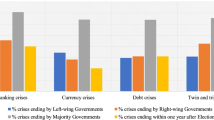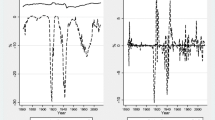Abstract
We employ the duration framework to study determinants of public debt cycles in 57 advanced and emerging economies over the 1960–2014 period, with a particular focus on the impact of financial cycles. The results suggest that the association between financial and debt cycles is asymmetric. Debt expansions preceded by overheating in credit and financial markets tend to last longer than other expansions, but there is no significant association between financial cycles and debt contractions. There is strong evidence of duration dependence in both phases of the cycle, with the likelihood of expansions and contractions to end increasing with the length of their respective spells. Higher initial level of debt increases the spell of contractions (persistence of adjustment effort hypothesis) and reduces the spell of expansions (debt sustainability hypothesis). The results are robust to the inclusion of global factors, openness, political stability, and debt crisis indicators as additional controls.






Similar content being viewed by others
Notes
There are two main differences between the VAR and duration methodologies: (i) the VAR assesses the impact of structural shocks to financial variables, while the duration framework assesses the impact of the cyclical turns in financial variables and (ii) the VAR assesses the impact on the magnitude of the debt ratio, while the duration framework assesses the impact on the length (duration) of debt expansions and contractions.
The earlier version of the paper was published as an IMF working paper (Baldacci et al. 2010).
This algorithm extends the so-called BB algorithm pioneered by Bry and Boschan (1971).
There are several reasons why we choose to use the debt ratio in levels. First, we are using a ratio of two trending variables (debt and GDP). The division is expected to remove the common trend in both variables. Second, from the debt sustainability point of view, the debt ratio should be bounded from above. This further supports the choice of using cycles in levels. Third, detrended values may not be comparable across countries. For instance, positive cyclical component for a country with a low initial level of debt may not be comparable with a positive cyclical component for a country with a high initial level of debt. Finally, market participants and policymakers are closely watching the level of the debt ratio as a public sustainability indicator, rather than its detrended values.
The results remain qualitatively unchanged when using Gompertz and exponential duration models.
We also use contemporary changes in real GDP growth, inflation, nominal interest rate, and primary balance variables over the respective phase of the cycle, but results remain qualitatively unchanged.
IMF (2015) provides a comprehensive discussion of transmission channels from banking crises to sovereign debt buildups.
References
Afonso A, Baxa J, Slavik M (2011) Fiscal developments and financial stress: a threshold VAR analysis. ECB working paper no. 1319. European Central Bank, Frankfurt
Baldacci E, Gupta S, Mulas-Granados C (2010) Restoring debt sustainability after crises: implications for the fiscal mix. IMF working paper no. 10/232. International Monetary Fund, Cambridge
Baldacci E, Gupta S, Mulas-Granados C (2012) Reassessing the fiscal mix for successful debt reduction. Econ Policy 27(71):365–406
Benetrix A, Lane P (2013) Fiscal cyclicality and EMU. J Int Money Finance 34:164–176
Bry G, Boschan C (1971) Cyclical analysis of economic time series: selected procedures and computer programs. NBER technical working paper no. 20. National Bureau of Economic Research, Cambridge
Budina N, Gracia B, Hu X, Saksonovs S (2015) Recognizing the bias: financial cycles and fiscal policy. IMF working paper. International Monetary Fund, Cambridge (forthcoming)
Claessens S, Kose A, Terrones M (2009) What happens during recessions, crunches, and busts? Econ Policy 60:653–700
Claessens S, Kose A, Terrones M (2012) How do business and financial cycles interact? J Int Econ 87:178–190
Claessens S, Kose A, Terrones M (2014) The global financial crisis: how similar? how different? how costly? In: Claessens S, Kose A, Laeven L, Valencia F (eds) Financial crises: causes, consequences, and policy responses. International Monetary Fund, Cambridge
Crowe C, Rabanal P, Dell’Ariccia G, Igan D (2011) How to Deal with Real Estate Booms; Lessons from Country Experiences. IMF Working Papers 11/91, International Monetary Fund
De Mooij R (2012) Tax biases to debt finance: assessing the problem, finding solutions. Fiscal Stud 33:489–512
Debrun X, Hauner D, Kumar M (2009) Independent fiscal agencies. J Econ Surv 23:44–81
Dell’Ariccia G, Igan D, Laeven L (2012) Credit booms and lending standards: evidence from the subprime mortgage market. J Money Credit Bank 44:367–384
Escolano J (2010) A practical guide to public debt dynamics, fiscal sustainability, and cyclical adjustment of budgetary aggregates. IMF technical notes and manuals no. 10/02. International Monetary Fund, Cambridge
Gupta S, Baldacci E, Clements B, Tiongson E (2005) What sustains fiscal consolidations in emerging market countries? Int J Finance Econ 10:307–321
Harding D, Pagan A (2002) Dissecting the cycle: a methodological investigation. J Monetary Econ 49:365–381
Heylen F, Everaert G (2000) Success and failure of fiscal consolidation in the OECD: a multivariate analysis. Public Choice 105:103–124
IMF (2015) From banking to sovereign stress: implications for sovereign debt. IMF policy paper. https://www.imf.org/external/np/pp/eng/2014/122214.pdf
Jordà O, Schularick M, Taylor A (2016) Sovereigns versus banks: credit, crises, and consequences. J Eur Econ Assoc 14(1):45–79
Laeven L, Valencia F (2012) Systemic banking crises database: an update. IMF working paper no. 12/163. International Monetary Fund, Cambridge
Lambertini L, Tavares J (2005) Exchange rates and fiscal adjustments: evidence from the OECD and implications for the EMU. Contrib Macroecon 5(1):1–28
Liu E, Mattina T, Poghosyan T (2015) Correcting “beyond the cycle:” accounting for asset prices in structural fiscal balances. IMF working paper no. 15/109. International Monetary Fund, Cambridge
Lutz B (2008) The connection between house price appreciation and property tax revenues. Finance and economics discussion series no. 2008-48. Federal Reserve Board, Cambridge
Maroto R, Mulas-Granados C (2008) What makes fiscal consolidations last? a survival analysis of budget cuts in Europe (1960–2004). Public Choice 134(3–4):147–161
Marshall M, Jaggers K (2002) Polity IV data set. University of Maryland, Center for International Development and Conflict Management
Mauro P, Romeu R, Binder A, Zaman A (2013) A modern history of fiscal prudence and profligacy. IMF working paper no. 13/5. International Monetary Fund, Cambridge
Perotti R (2011) The “austerity myth:” gain without pain?”. NBER working paper no. 17571. National Bureau of Economic Research, Cambridge
Reinhart C, Rogoff K (2009) This time is different: eight centuries of financial folly. Princeton University Press, Princeton
Von Hagen J, Strauch R (2001) Fiscal consolidations: quality, economic conditions, and success. Public Choice 109:327–346
Von Hagen J, Hughes Hallett A, Strauch R (2002) Budgetary consolidation in Europe: quality, economic conditions, and persistence. J Jpn Int Econ 16:512–535
Author information
Authors and Affiliations
Corresponding author
Additional information
I would like to thank Bernardin Akitoby, Tamim Bayoumi, Julio Escolano, Karina Garcia, Vitor Gaspar, Deniz Igan, Luis Jacome, Carlos Mulas-Granados, Martin Saldias, Damiano Sandri, Abdelhak Senhadji, Cesar Serra, Marzie Taheri Sanjani, and seminar participants at IMF’s Fiscal Affairs Department for useful comments and suggestions. Macarena Torres Girao provided excellent editorial assistance. The views expressed in this paper are those of the author and do not necessarily represent those of the IMF or IMF policy.
Rights and permissions
About this article
Cite this article
Poghosyan, T. How do financial cycles affect public debt cycles?. Empir Econ 54, 425–460 (2018). https://doi.org/10.1007/s00181-016-1215-0
Received:
Accepted:
Published:
Issue Date:
DOI: https://doi.org/10.1007/s00181-016-1215-0




